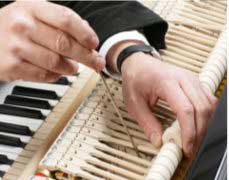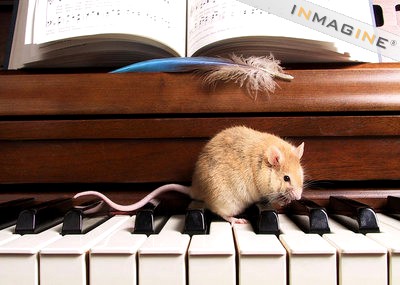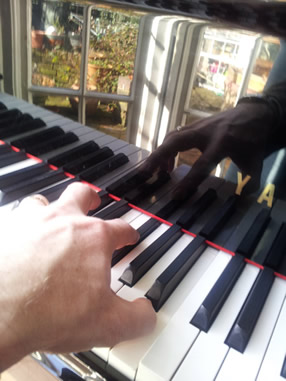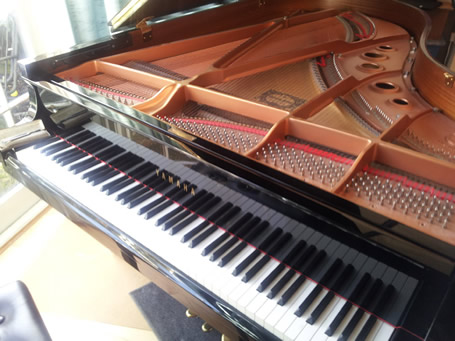Ask Derek
Here are some of the questions I am often asked about pianos and piano tuning.
If you have any other query, please send it to derek@derekwrightpiano.co.uk
 Q. I've heard of "regulation". What is it, and does my piano need it?
Q. I've heard of "regulation". What is it, and does my piano need it?
A. A piano is a machine of sorts and therefore sometime needs attention from a "mechanic". The parts of the action will wear and compress with time and use. Periodically the action will need regulating. This is adjusting everything to take up lost motion and ensure the notes work efficiently. Gaps between regulating can often be many years. The cost of regulating varies depending on how much needs to be done.
Q. Could something be broken?
A. From time to time there may be breakages in the action, especially in older pianos. These can usually be put right relatively easily, provided there aren’t too many of them, but sometimes, when a piano reaches a certain age, one part breaking is a sign of more to come. Piano strings can break too, though this is a relatively rare occurrence. The strings can become rusty and this weakens them. They are most likely to break during tuning – that doesn’t mean it’s the piano tuner’s fault! Your tuner can usually replace them with the correct gauge wire when he or she comes, but the bass strings have copper wire covering a steel core and are all different. The broken string will need to be sent away so a copy can be made. It doesn’t usually take very long, but the tuner will have to make a second visit to fit the replacement bass string when it arrives.
Q. My piano doesn't stay in tune.
 A. The wrest pins (tuning pins) can become loose, allowing strings to slacken and go out of tune. It is a very serious problem and is the most common cause of a piano’s demise. The problem is not generally the pins themselves, but the wrest plank, which is the block of wood into which they are set. The wrest plank, especially on an older piano may dry out and shrink when exposed to the very dry atmosphere of a modern centrally heated home. The plank literally loses its grip on the pins and they start to unwind allowing the strings to fall out of tune. Care should be taken not to allow the humidity to get too low, especially if your piano predates central heating being the norm. Newer pianos cope much better as the wood used is dried more thoroughly now, but extremes of humidity - low or high – are not good for any piano. A piano with loose wrest pins may need restringing using larger pins. This is quite expensive and often costs more than the value of the piano. Even then, it isn’t always the answer as a damaged plank can split. Replacing a plank involves totally rebuilding a piano and will cost a similar amount to buying a new one!
A. The wrest pins (tuning pins) can become loose, allowing strings to slacken and go out of tune. It is a very serious problem and is the most common cause of a piano’s demise. The problem is not generally the pins themselves, but the wrest plank, which is the block of wood into which they are set. The wrest plank, especially on an older piano may dry out and shrink when exposed to the very dry atmosphere of a modern centrally heated home. The plank literally loses its grip on the pins and they start to unwind allowing the strings to fall out of tune. Care should be taken not to allow the humidity to get too low, especially if your piano predates central heating being the norm. Newer pianos cope much better as the wood used is dried more thoroughly now, but extremes of humidity - low or high – are not good for any piano. A piano with loose wrest pins may need restringing using larger pins. This is quite expensive and often costs more than the value of the piano. Even then, it isn’t always the answer as a damaged plank can split. Replacing a plank involves totally rebuilding a piano and will cost a similar amount to buying a new one!

Q. I think something's living in my piano!
A. Pianos can be home to moths, mice and woodworm. All of these can seriously damage it and indeed other things in your home. The moths eat the felt in the action and keys which is made of wool. If you see moths in or around your piano, call a piano tuner in to assess any damage and take action to repell the moths. Mice can nest in pianos – often under the key bed. They usually get in through the spaces under the pedals. They rip out felt to use as bedding and nibble leather and wood in the action and keys. Woodworm infestation should be treated by a pest control specialist as a matter of urgency, as should mice.
Q. What should I clean the keys of my piano with?
A. The best advice I can give is a very slightly damp cloth. I must emphasise slightly damp. Squeeze out as much water as you can as you don’t want water getting anywhere except the keytops. New pianos have plastic keytops which really are just wipe-clean! Some older pianos, but by no means all, have ivory keytops. Ivory is more problematic as is porous, so dirt can get below the surface. It is best to clean the keys regularly to stop dirt from becoming ingrained in the ivory. Dust and grease from your skin will gradually add to the discolouration of ivory.

Q. Are Ivory Keys better than plastic ones?
A. This is a matter of opinion. Personally I think that ivory, in spite of its much higher cost, is inferior to plastic. Plastic keytops don’t wear or discolour nearly as much as ivory. They are moulded as a one-piece keytop where Ivory is almost always put on in 3 pieces – a narrow piece at the back of the keytop to go between the black notes, a wider piece at the front and a third on the front edge. The join between the pieces on the top becomes more noticeable with age and the accumulation of dirt. Ivories tend to yellow with time and also often come off when a keyboard has reached a certain age. If this happens, don’t lose the top as they are very difficult to source these days. Get your piano tuner to stick it back on for you as it is likely to need clamping or the glue can make the ivory curl.
There are plenty of people who prefer ivory keys. They say that fingers can slip on plastic, particularly if perspiring. I personally have never found this (perhaps I don’t get sweaty fingers!). I think it’s just a question of what you are used to. Plastic keytops are of course kinder to elephants!
Q. What is Concert Pitch?
A. Concert Pitch, or more correctly International Standard Pitch is a set frequency which musical instruments of all shapes and sizes are built to match so they are in tune with each other. Concert A, the middle A on a piano, is 440 hertz. This means that the sound produced by that note is made up of 440 vibrations per second. A tuning fork for Concert A always produces this pitch. ISP was only agreed upon just under 100 years ago. Before that, there was no standard and different geographical areas and eras in history chose different pitches. Consequently Baroque music, for instance, if played on modern instruments is usually much higher than the composer originally intended.
If a piano is left without being tuned for some years, it will drop significantly in pitch. When it is tuned, the tuner will need to do more than one tuning in order to get it back to Concert Pitch. This obviously costs a bit more as it takes longer. Occasionally, the owner doesn’t wish to pay the extra and the piano is tuned to the pitch it has arrived at. In theory at least, this only makes a difference if the piano needs to be played with other instruments, as it will be in tune with itself. I must stress though, that a piano is not meant to be tuned below pitch, it isn’t designed to be tuned below pitch and will sound its best with the strings stretched tightly as they were meant to be.
Sometimes a piano is left below pitch because it is in poor condition and is unlikely to stay in tune well if the pitch is raised. In my experience, if a piano won’t hold a tuning well at concert pitch, it is probable that it won’t hold particularly well below pitch either!

Q. Why do pianos go out of tune?
A. Pianos are partly organic – by which I mean a lot of a piano is wood. Wood is inclined to swell and contract when there are changes in humidity and temperature. Changes in the season and indeed the day to day weather will change the amount of stretch on the strings and thus change their pitch. The strings are stretched across the wooden bridge which is attached to the soundboard. There is an angle at the point where the strings cross the bridge to ensure the strings press into the bridge and allow their vibrations to be transferred to the soundboard. I hope you’re following this! The soundboard is not quite flat, but “crowned” – it bulges in the middle where the bridge is. When the humidity increases, the wood of the soundboard swells and increases the crown, thus pushing the bridge up which in turn increases the tension of the strings and raises their pitch. Conversely when humidity is lowered, the crown sinks and the strings go flat.
The down bearing angle or the strings crossing the bridge puts enormous pressure on the soundboard. Over the period of a piano’s life, the crown gradually flattens out due to this pressure. Consequently, although there may be short term rises in pitch, the general trend over time is that the piano goes flat.

There are lots of places not to keep a piano, in fact if everyone followed all the advice, far fewer people would have pianos as they would have nowhere to put them! The main concern is not to place it close to a heat source. Do not put a piano in a room with underfloor heating unless you can stand it on some form of insulation, it will write the piano off! So will placing the piano against a radiator. A stud wall with a radiator on the other side can have a similar effect. A conservatory is not a great place as it may get extremes of hot and cold which will put the piano out of tune and may damage it irrepairably. It is good to avoid placing your piano against an outside wall if you can (mine is though and it copes!), and try to keep it from direct sunlight. Good luck with that then – as I say, the heat source is the most important thing to avoid!

